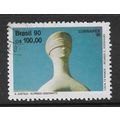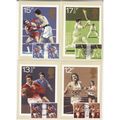Animal - African Cape Buffalo - Salmon postcard 1970s
- Condition : Used
- Dispatch : 2 Days
- Brand : None
- ID# : 93647544
- Quantity : 1 item
- Views : 355
- Location : United Kingdom

- Seller : justthebook (+1704)
- Barcode : None
- Start : Sat 23 Feb 2013 15:40:39 (EDT)
- Close : Run Until Sold
- Remain : Run Until Sold
Checks/Cheques
 for 1 item(s) edit
for 1 item(s) edit
Shipping Calculator
More Listings from This Seller view all
Seller's Description
- Postcard
- Picture / Image: African Wild Life - Cape Buffalo
- Publisher: J Salmon (6-25-60-53)
- Postally used: no
- Stamp: n/a
- Postmark(s): n/a
- Sent to: n/a
- Notes / condition:
Check out my !
Please ask if you need any other information and I will do the best I can to answer.
------------------------------------------------
Postage & Packing:
UK (incl. IOM, CI & BFPO): 99p
Europe: £1.60
Rest of world (inc. USA etc): £2.75
No additional charges for more than one postcard. You can buy as many postcards from me as you like and you will just pay the fee above once. (If buying postcards with other things such as books, please contact or wait for invoice before paying).
Payment Methods:
UK - PayPal, Cheque (from UK bank) or postal order
Outside UK: PayPal ONLY (unless otherwise stated) please. NO non-UK currency checks or money orders (sorry).
NOTE: All postcards are sent in brand new stiffened envelopes which I have bought for the task. These are specially made to protect postcards and you may be able to re-use them. In addition there are other costs to sending so the above charge is not just for the stamp!
I will give a full refund if you are not fully satisfied with the postcard.
----------------------------------------------
Text from the free encyclopedia WIKIPEDIA may appear below to give a little background information (internal links may not work) :
*************
The African buffalo, affalo, nyati, mbogo or Cape buffalo (Syncerus caffer), is a large African bovine. It is not closely related to the slightly larger wild Asian water buffalo, but its ancestry remains unclear. Owing to its unpredictable nature, which makes it highly dangerous to humans, it has not been domesticated unlike its Asian counterpart the domestic Asian water buffalo. Contrary to popular belief, the African buffalo is not the ancestor of domestic cattle, and is only distantly related to other larger bovines.
The African buffalo is a very robust species. Its shoulder height can range from 1 to 1.7 m (3.3 to 5.6 ft) and its head-and-body length can range from 1.7 to 3.4 m (5.6 to 11 ft). Compared with other large bovids, it has a long but stocky body (the body length can exceed the Wild water buffalo, which is rather heavier and taller) and short but thickset legs, resulting in a relatively short standing height. The tail can range from 70 to 110 cm (28 to 43 in) long. Savannah-type buffaloes weigh 500 to 910 kg (1,100 to 2,000 lb), with males normally larger than females, reaching the upper weight range.[2] In comparison, forest-type buffaloes, at 250 to 455 kg (550 to 1,000 lb), are only half that size.[3][4] Its head is carried low; its top is located below the backline. The front hooves of the buffalo are wider than the rear, which is associated with the need to support the weight of the front part of the body, which is heavier and more powerful than the back.
Savannah-type buffaloes have black or dark brown coats with age. Old bulls have whitish circles around their eyes. Females tend to have more reddish coats. Forest-type buffaloes are reddish brown in colour with horns that curve back and slightly up. Calves of both types have red coats.
The horns of African buffalo are very peculiar. A characteristic feature of them is the adult bull's horns have fused bases, forming a continuous bone shield referred to as a ""boss"", which can not always be penetrated even by a rifle bullet. From the base, the horns diverge, then bend down, and then smoothly curve upwards and outwards. The distance between the ends of the horns of large bulls is more than a metre. The young buffalo horn boss forms fully only upon reaching the age of five to six years. In cows, the horns are, on average, 10–20% smaller, and the boss is less prominent. Forest buffalo horns are much smaller and weaker than those of the savannah buffaloes and are almost never fused. They rarely reach a length of even 40 cm.
type=printed postcards
theme=animals
sub-theme=buffalo
number of items=single
period=1945 - present
postage condition=unposted
Listing Information
| Listing Type | Gallery Listing |
| Listing ID# | 93647544 |
| Start Time | Sat 23 Feb 2013 15:40:39 (EDT) |
| Close Time | Run Until Sold |
| Starting Bid | Fixed Price (no bidding) |
| Item Condition | Used |
| Bids | 0 |
| Views | 355 |
| Dispatch Time | 2 Days |
| Quantity | 1 |
| Location | United Kingdom |
| Auto Extend | No |




















